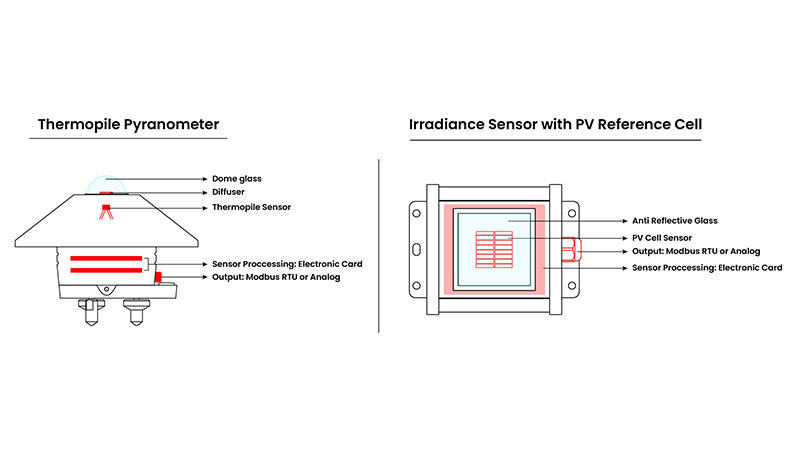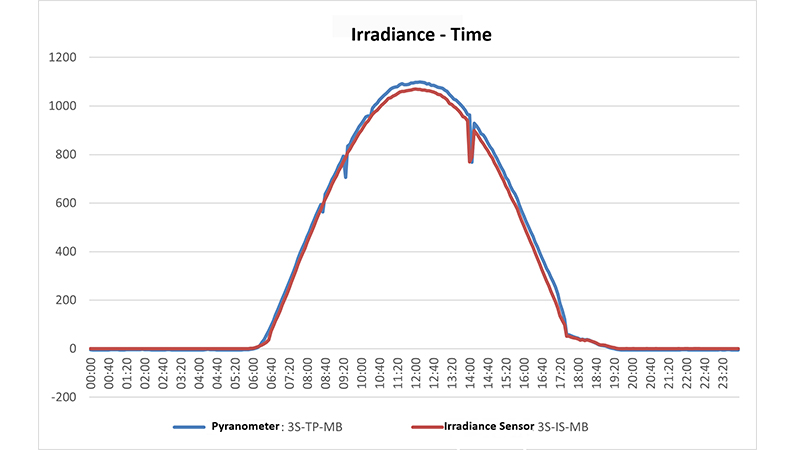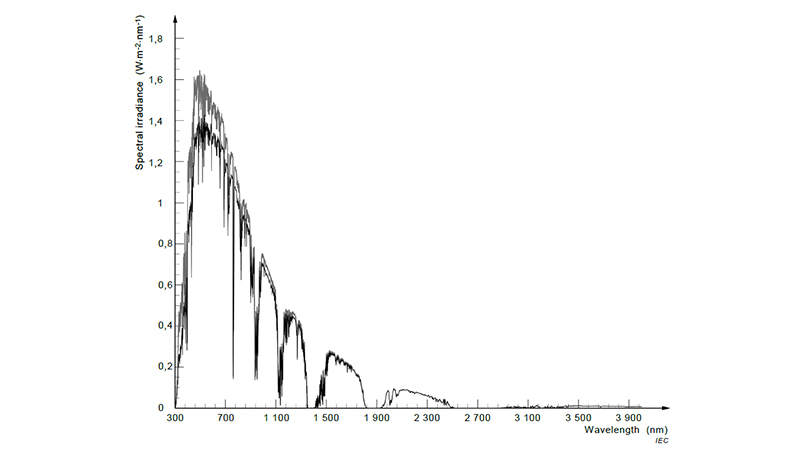In solar power plants (SPP), POA – Plane of Array measurement forms the basis for field performance ratio (PR) calculations.
The two sensor types most commonly used in the field for POA measurement are from SEVEN Sensor Solution:
Both of these devices can be used for POA (Plane of Array) measurement; however, their measurement principles, accuracy, and results differ. So, which of these two sensors provides more accurate measurements? Why do they give different results when used side by side?
What is a SEVEN Thermopile Pyranometer?
Thermopile Pyranometers measure shortwave radiation from the sun in the 280–3000 nm spectrum range. Key features of the SEVEN 3S-TP-MB-A Thermopile Pyranometer:
- Provides high accuracy in accordance with IEC 61724-1 and ISO9060 Class A standards.
- Uses a thermopile sensor element that converts temperature differences into electrical signals.
- Detects the entire solar spectrum (280–3000 nm) (UV + visible + IR).
- Accurately measures GHI and POA radiation components.
- Provides long-term stable measurements.
What is a SEVEN PV Reference Cell Irradiance Sensor?
PV Reference Cell Irradiance Sensors typically measure in the 280–1200 nm wavelength range. Key features of the SEVEN 3S-IS PV Reference Cell Irradiance Sensor:
- Provides high accuracy in accordance with the IEC61724 Class A standard.
- Uses a monocrystalline silicon cell.
- Spectral sensitivity is approximately 280–1200 nm (UV + visible + near-IR).
- Accurately measures POA radiation components.
- Cost-effective.
Comparison of Thermopile Pyranometer and PV Reference Cell Irradiance Sensor Structure

Figure 1 – Comparison of Thermopile Pyranometer and PV Reference Cell Irradiance Sensor Structure
Termopil Pyranometer and PV Reference Cell Irradiance Sensor Field Test
SEVEN Sensor Solutions conducted comparison tests between the Thermopile Pyranometer and the PV Reference Cell Irradiance Sensor at the Çorum Organized Industrial Zone between March 13, 2024, and May 6, 2024, over a period of approximately two months. Upon reviewing the test results, it was determined that the Thermopile Pyranometer exhibited higher radiation values compared to the PV Reference Cell Irradiance Sensor. This difference is normal even when both are oriented in the same direction and same angle. The primary reason is the spectral response. The Thermopile Pyranometer provides a spectrally uniform response to total short-wave radiation in the 280–3000 nm range. The Irradiance Sensor, on the other hand, is sensitive to the approximately 280–1200 nm band and is largely blind in the near-infrared (NIR) region. Therefore, the pyranometer adds the radiation values of wavelengths across a broader spectral range to the total radiation it measures.

Figure 2 – Comparison Graph of Thermopile Pyranometer and Irradiance Sensor in Clear and Stable Weather
According to Figure 1, when the weather is clear and stable, the average difference between the Thermopile Pyranometer and the Irradiance Sensor is 5.26%. The pyranometer measures higher values.
It is also normal for the pyranometer to show higher values when the sun rises and sets. This is because the pyranometer has a field of view of 180 degrees, while the ırradiance sensor has a field of view of around 160-170 degrees. However, the main reason is that when the sun is at a low angle, the path through the atmosphere lengthens, shifting the spectrum more toward the red and IR regions. PV cells detect these longer wavelengths weakly. The pyranometer, being sensitive to IR, shows relatively higher values during these hours.
What are the Energies of the Spectral Ranges?

“Figure 1 is included in the IEC 60904-3:2019 standard. It can be used directly without any changes.”
AM1.5G, ASTM G-173 “global tilt” and IEC60904-3 reference, 1 sun ≈ 1000.4 W/m²:
- 280–400 nm ≈ 5.02%, approximately 50.25 W/m².
- 400–1200 nm ≈ 76.57%, approximately 765.81 W/m².
- 1200–3000 nm ≈ 18.40%, approximately 184.03 W/m².
- The contribution beyond 2500 nm is very small, so the 1200–3000 nm band represents the remaining portion of the shortwave.
Differences in POA Measurements at the Same Azimuth and Zenith Angles
| Situation | Which one measures higher? | Reason |
| Clear and sunny midday | Thermopile Pyranometer | Detects a broad spectrum (UV + Visible + NIR); PV reference cell cannot measure the IR (≈1200 nm and above) region. |
| Cloudy/diffuse radiation | Depends on the situation (usually Thermopile is slightly higher) | The PV sensor is sensitive to blue-dominant diffuse light; the thermopile retains its broad spectrum advantage. |
| Morning/evening (high zenith angle) | Thermopile Pyranometer | The spectrum is enriched in NIR, which the PV cell cannot measure; additionally, the dome glass allows for a wider field of view, better capturing low-angle radiation (cosine response advantage). |
| Very bright sun + low temperature | Similar values | Spectral differences are minimal; temperature-related losses are low. |
Should a Thermopile Pyranometer or PV Reference Cell be Preferred for POA?
The choice of POA (Plane of Array) measurement is directly related to the objective of the measurement. If the objective is to measure the irradiance reaching the cell plane of the PV module as close as possible to the spectral and temperature response of the module, the PV Reference Cell Sensor is more suitable because it has similar spectral sensitivity to the module.
However, if a measurement that includes long-wavelength components, is independent of spectral changes, and has high long-term calibration stability is desired, a Thermopile Pyranometer should be preferred. In many field applications, using both sensors together enhances the reliability of POA data by enabling a more accurate analysis of the effects of spectral changes and atmospheric conditions.
Cost Comparison of Thermopile Pyranometer and Irradiance Sensor with PV Reference Cell
The Thermopile Pyranometer is at least five times more expensive than the PV Reference Cell Irradiance Sensor. This is due to the difference in technology between the two. The pyranometer was designed in the early 1900s and was based on meteorological measurement needs. The PV Reference Cell Irradiance Sensor, on the other hand, was designed in the early 2000s to measure irradiance values required for calculating the performance ratio in PV systems.
Feature Comparison Table
| Feature / Criterion | Thermopile Pyranometer | Reference Cell Irradiance Sensor |
| Sensor | Thermopile (thermal pair array) | Photovoltaic cell (monocrystalline silicon cell) |
| Standard Classes | According to ISO 9060: Secondary Standard, First Class, Second Class | According to IEC 60904: generally classified according to PV cell classes, not officially covered by ISO 9060 |
| Spectral Measurement Range | 280–3000 nm (close to the entire solar spectrum) | 280–1200 nm (PV cell sensitivity range, limited) |
| Type of Irradiance Measured | GHI, POA | POA |
| Cost | Higher (5X) | Lower (X) |
Seven Sensor Solutions
SEVEN Sensor offers both Class A, B, and C high-accuracy thermopile pyranometers for PV power plants in accordance with ISO9060, as well as reliable PV Reference Cell Irradiance Sensors in accordance with IEC61724:
The “correct” sensor for POA measurement varies depending on the purpose of the measurement. Pyranometers with thermopiles measure total irradiance from the atmosphere most accurately thanks to their wide spectral coverage, high cosine accuracy, and long-term stability. In contrast, irradiance Sensors with PV reference cells are used in performance analyses because they reflect the actual electrical response of the module. In side-by-side measurements, the Thermopile Pyranometer typically provides the total Global Irradiance in the horizontal plane. Therefore, no single device is “more accurate” in an absolute sense; the pyranometer best represents the physical reality of atmospheric irradiance, while the PV reference cell sensor best simulates module behavior. The most reliable assessment is achieved by analyzing data from both sensors together.
The sensor selection should be made according to the accuracy requirements, budget, and intended use of the project. For more information, please contact SEVEN Sensor Solution.
FAQ – Frequently Asked Questions
1. Does a pyranometer or an irradiance sensor with a PV reference cell measure more accurately?
Accuracy depends on what you want to measure. The pyranometer is the most physically accurate measure of the total broad-wavelength wave radiation from the atmosphere, while the PV reference cell sensor best reflects the electrical response of the module.
2. Why do pyranometers and PV reference cell irradiance sensors show different values?
The reason for this is differences in spectral sensitivity and viewing angle. Pyranometers measure a broad spectrum (280–3000 nm), while PV sensors operate in the 280–1200 nm range. The Thermopile Pyranometer has a 180° viewing angle, while the PV Reference Cell Irradiance Sensor has a 160° viewing angle.
3. Which sensor should I use for POA measurement?
The most reliable results are obtained by evaluating data from both the Thermopile Pyranometer and the PV Reference Cell Irradiance Sensor together. This allows both atmospheric irradiance conditions and PV module response to be accurately analyzed. But if there is a budget constraint, PV Reference Cell Irradiance Sensors can be preferred.
